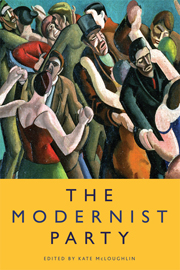Book contents
- Frontmatter
- Contents
- A Note of Thanks
- The Guest List
- Introduction: A Welcome from the Host
- 1 ‘The dinner was indeed quiet’: Domestic Parties in the Work of Joseph Conrad
- 2 Prufrock, Party-Goer: Tongue-Tied at Tea
- 3 Party Joyce: From the ‘Dead’ to When We ‘Wake’
- 4 ‘Looking at the party with you’: Pivotal Moments in Katherine Mansfield's Party Stories
- 5 Virginia Woolf's Idea of a Party
- 6 Proustian Peristalsis: Parties Before, During and After
- 7 ‘Ezra through the open door’: The Parties of Natalie Barney, Adrienne Monnier and Sylvia Beach as Lesbian Modernist Cultural Production
- 8 ‘Indeed everybody did come’: Parties, Publicity and Intimacy in Gertrude Stein's Plays
- 9 The Interracial Party of Modernist Primitivism and the Black ‘After-Party’
- 10 The Party In Extremis in D. H. Lawrence's Women in Love
- 11 Bohemian Retrospects: Ford Madox Ford, Post-War Memory and the Cabaret Theatre Club
- 12 ‘Pleasure too often repeated’: Aldous Huxley's Modernity
- Index
10 - The Party In Extremis in D. H. Lawrence's Women in Love
Published online by Cambridge University Press: 05 April 2014
- Frontmatter
- Contents
- A Note of Thanks
- The Guest List
- Introduction: A Welcome from the Host
- 1 ‘The dinner was indeed quiet’: Domestic Parties in the Work of Joseph Conrad
- 2 Prufrock, Party-Goer: Tongue-Tied at Tea
- 3 Party Joyce: From the ‘Dead’ to When We ‘Wake’
- 4 ‘Looking at the party with you’: Pivotal Moments in Katherine Mansfield's Party Stories
- 5 Virginia Woolf's Idea of a Party
- 6 Proustian Peristalsis: Parties Before, During and After
- 7 ‘Ezra through the open door’: The Parties of Natalie Barney, Adrienne Monnier and Sylvia Beach as Lesbian Modernist Cultural Production
- 8 ‘Indeed everybody did come’: Parties, Publicity and Intimacy in Gertrude Stein's Plays
- 9 The Interracial Party of Modernist Primitivism and the Black ‘After-Party’
- 10 The Party In Extremis in D. H. Lawrence's Women in Love
- 11 Bohemian Retrospects: Ford Madox Ford, Post-War Memory and the Cabaret Theatre Club
- 12 ‘Pleasure too often repeated’: Aldous Huxley's Modernity
- Index
Summary
In Women in Love, D. H. Lawrence created some of the most intense representations of early twentieth-century English parties to be found. Published in 1920, the novel had been completed in 1917, and it was difficult for contemporaries not to read the party sequences as recreations of the author's interactions with Lady Ottoline Morrell and her circle at her Oxfordshire country home, Garsington Manor. Lawrence and his wife Frieda were among the very first guests invited to Garsington – to attend a small birthday-party for Morrell on 16 June 1915 – and they were frequent and sometimes contentious guests there in the ensuing year. Garsington was flamboyantly decorated and beautifully landscaped and Lady Morrell had ‘created a magic reflection of her visitors' dreams and illusions’ with the place, Michael Holroyd notes. But Holroyd goes on to say that ‘[w]henever these dreams and illusions vanished, her guests would take their revenge on her’. Lawrence belonged to this disillusioned cohort and even before the publication of Women in Love, his friendship with Morrell was already ‘in retreat’. When the novel was published, her portrayal as Hermione Roddice in the book struck her as a shocking betrayal and the friendship ended in grief and bitterness. But the ‘Breadalby’ and ‘Water-Party’ chapters in the novel offer much more than a satirical memoir, although they do explore the social dimensions of class differences, public aesthetics and power relations.
- Type
- Chapter
- Information
- The Modernist Party , pp. 178 - 191Publisher: Edinburgh University PressPrint publication year: 2013



